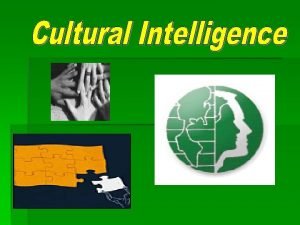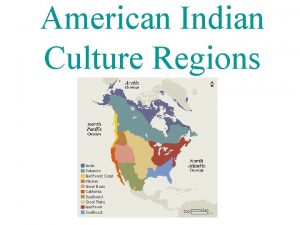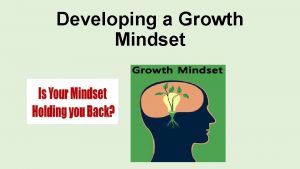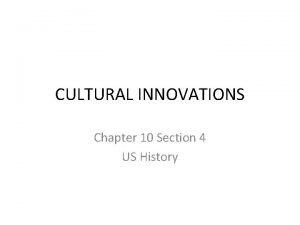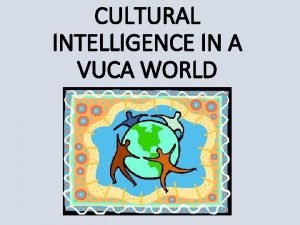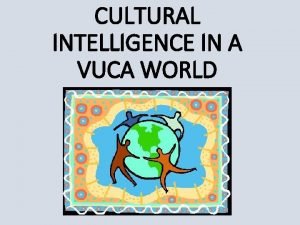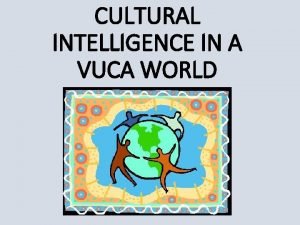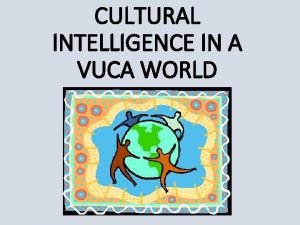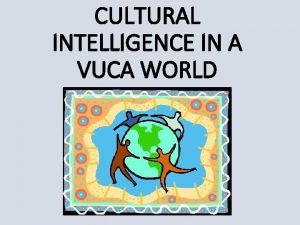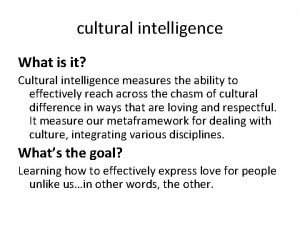CULTURAL INTELLIGENCE IN A VUCA WORLD Lesson 3










- Slides: 10

CULTURAL INTELLIGENCE IN A VUCA WORLD

Lesson 3: Cultural Identity LEARNING OBJECTIVE • It is essential to first understand who we are before we can understand others, so in this module you will explore who you are in terms of your values, beliefs, attitudes, and other socio -cultural identities, such as ethnicity, language, gender, education, age, religion, and more. KEY TAKEAWAYS • • Define the meaning of individual cultural identity. Explain, in concrete terms, what identity negotiation means. Articulate the manifestations of one’s salience in identity. Discuss any personal experience regarding enculturation and/or acculturation List the types of social and cultural identities described in this lesson and contemplate the ones that resonate with you. Identify any experiences with anxiety in managing uncertainty. Explain the definition of ethnicity and distinguish the new definition of race with the old one. LEADERSHIP APPLICATIONS • CQ leaders who understand the socio-cultural issues relating to identity will grasp the importance of their personal attributes and many different roles as they negotiate meaning with others.

Cultural Identity & Identity Negotiation Cultural Identity is the emotional significance that we attach to our sense of belonging or affiliation with the larger culture. v All of us are socialized within a larger cultural membership group. • We are often asked – where do you come from? • There are ‘in-groups’ and ‘outgroups’ to which we belong. v Cultural Identity Salience • The degree to which we attach our emotional significance. Identity Negotiation is how people interact with each other and understand “who is who” in their relationships. • People have expectations about each other’s identity (they tacitly agree and assume you are who you are). • It’s a process that establishes what we can expect from each other. • Think of it as “interpersonal glue” that sticks you together within your relationships. When someone asks you where you're from … do you sometimes not know how to answer? Writer Taiye Selasi speaks on behalf of "multi-local" people, who feel at home in the town where they grew up, the city they live now and maybe another place or two. "How can I come from a country? " she asks. "How can a human being come from a concept?

Social & Cultural Identities Gudykunst & Kim v. Cultural or Ethnic Identities: aspects of a group’s cultural background – belonging to the same ethnic category (e. g. , Asian American, Japanese American, etc. ) v. Language Identities: languages often mark boundaries between our ethnic/national origins and others. . Language is one of the major criterion for ethnic group membership. v. Gender Identities: the way we define our gender roles, which are the psychological traits and the social responsibilities that individuals have and feel are appropriate for them because they are male. Gender roles also include our sexual orientations. v. Disability Identities: whether we are perceived to have a noticeable disability or not. Sometimes disabilities are noticeable. v. Age Identities: where we are in terms of our chronological order. v. Social Class Identities: we are in terms of our position in society – not just socio-economic, but also includes aspect of intelligence. v. Role Identities: we can define ourselves in terms of the behavioral expectations associated with a particular position in a group (e. g. , multiple roles as a mother, daughter, sister, friend, employee, caregiver).

Individual Cultural Identity • We are each unique • Enculturation • Acculturation Marshall Singer, a cultural anthropologist and intercultural expert has a stimulating perspective on culture – that we are each culturally unique (we are not individual cultures – just unique). “…Each individual in this world is a member of a unique collection of groups. No two humans share only and exactly the same group memberships, or exactly the same ranking of the importance, to themselves, of the group membership they do share. Thus, each person must be culturally unique. ”

A Metaphor Let’s look at a creative way for understanding cultural identity. Take a few moments to ponder Singer’s analogy of culture via a cake metaphor. What do you think about his idea below and how do you make sense of this in light of your own understanding of culture? “A chocolate cake is different than a fruit cake, yet they are both cake. They have more in common with each other than either does to a chocolate candy bar. But that doesn’t distract from the fact that the chocolate in the cake and the chocolate in the candy bar are much more similar to each other than they are to any of the other ingredients of either the cake or candy bar. ”

Uncertainty Anxiety Management Uncertainty-anxiety management, refers to intergroup interaction and that we experience anxiety when interacting with people who are unfamiliar to us. • Managing uncertainty is the cognitive ability to identify and predict the behavior of others while managing our uneasy feelings. • Success comes with controlling both uncertainty and anxiety • This leads us to understanding how to deal with difference when interacting with someone from a different group

Ethnicity relates to sociological factors that can include a shared language, nationality, religion, cultural traditions and group history. Ethnicity is defined in terms of shared ancestry. It can be actual or presumed. Often people will associate with a particular group based upon family stories passed down from generation to generation‑there is a nostalgic or emotional interest in being associated with a particular group‑and whether actual or imagined, the person will self-identify and believe them to be part of that group. Their salience, or emotional connection to the need to belong, creates bonds to a particular group membership.

Changes in the Definition of Race PBS “Race: The Power of an Illusion http: //www. pbs. org/race/000_General/000_00 -Home. htm 1. Race is modern social construction of identity: In ancient times, people were not classified according to their physical attributes; rather religion, status, and language. 2. Race is not genetic: There is no such thing as a gene that differentiates members of a “race” from another. Therefore race is not biological. 3. There are no subspecies of humans: Humans have not evolved into subspecies; rather, humans are the most similar of all species. 4. Skin color doesn’t define race: Humans inherit traits independently from another – so skin color isn’t connected to the genes that create blood type, hair, or shape of eyes – or intelligence or any other abilities. 5. Variation comes within and not between people of different “races”. Only a small amount of variation exists in human beings. If you pick two random people from the same people group, for example, a Czech person, they can be just as genetically different than a Czech and a Chinese person.

Summary It is essential to first understand who we are before we can understand others, so in this module you will explore who you are in terms of your values, beliefs, attitudes, and other socio-cultural identities, such as ethnicity, language, gender, education, age, religion, and more. • Each of us is culturally unique and therefore we have our own individual cultural identity. • Our personal identity is shaped by the people around us (family, social, institutional) – both in-groups and out-groups. • Through the process of enculturation, we are socialized to understand the implicit values, beliefs, attitudes, and behaviors expected and accepted in our groups. • Because we tend to be comfortable with the familiar, we find it hard to interact with people who are different, resulting in anxiety and uncertainty. • All of us are part of many groups – some holding more salience than others – whether they are language, ethnicity, age, gender, social class, education, ability or disability, and more. As a result, we have an emotional attachment to these aspects of our social identity. • Today, ethnicity has come to have an expanded definition, and race has a completely different meaning.
 Koga ne smijete prevoziti na prednjem sjedalu
Koga ne smijete prevoziti na prednjem sjedalu Vuca
Vuca Mundo vuca
Mundo vuca Diagnosing your cultural intelligence
Diagnosing your cultural intelligence Cultural regions of the world map
Cultural regions of the world map Chinese communist party ap world history
Chinese communist party ap world history Acculturation definition geography
Acculturation definition geography Malleable intelligence lesson
Malleable intelligence lesson Chapter 8 lesson 4 cultural innovations
Chapter 8 lesson 4 cultural innovations Opposable thumb primates
Opposable thumb primates New world to old world columbian exchange
New world to old world columbian exchange



